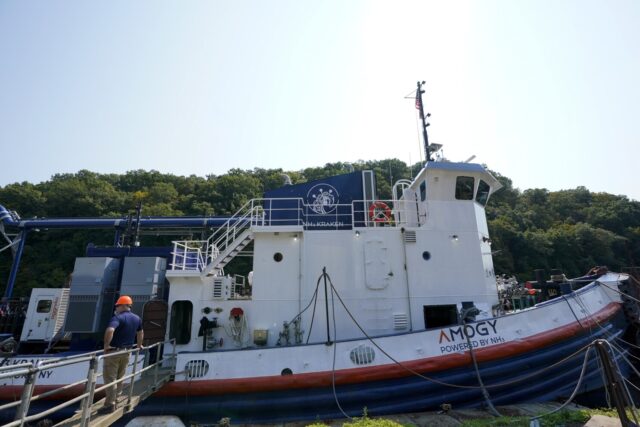NH3 Kraken sails on the Hudson River
By Julian Atchison on September 24, 2024
Ammonia-powered tug makes its debut in New York state

Click to learn more. The NH3 Kraken sails on the Hudson River near Kingston, powered by ammonia fuel. Source: Associated Press.
After a multi-year development process, Amogy has sailed its retrofitted tugboat for the first time on the Hudson River, north of New York City. Originally built in 1957 and retrofitted with Amogy’s ammonia-to-power system over the last couple of years, the vessel is now fully operational and able to sail on just ammonia fuel. Amogy plans to release further technical details and a comprehensive case study of the vessel in the coming months, and you can learn more about the vessel’s journey to ammonia power from a Maritime Insights webinar featuring Amogy Project Lead Abigail Jablanksky. For the demonstration, Amogy reports that the vessel was fueled with renewable ammonia
Governments across the globe and industry organizations like the IMO have set aggressive goals to reduce global carbon emissions. These goals seem daunting, but they’re necessary – and our successful demonstration of the world’s first carbon-free, ammonia-powered vessel proves that they’re achievable. By demonstrating our technology on the water for the first time, we’ve gained invaluable knowledge that will help us move quickly to commercialization and real-world applications. The opportunity to decarbonize the maritime industry is within reach, and for Amogy, it’s just the beginning…
Ammonia is the world’s second most produced chemical, with around 20 million tons moving around the globe through 200 ports each year. With that track record, shifting the industry mindset to use it as a fuel is completely achievable, and can happen at an accelerated pace.
Seonghoon Woo, CEO and Co-founder of Amogy in his organisation’s official press release, 23 Sept 2024
The NH3 Kraken is the largest application of Amogy’s technology to date, following successful demonstrations of an aerial drone, commercial farm tractor, and a semi-truck. Amogy has already established multiple maritime partnerships in key global shipping locations globally (including Singapore, Japan and Europe), and aims to deploy their technology in a variety of marine scenarios.
